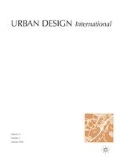Abstract
Urban renewal continues to play a major role in shaping the contemporary Chinese city. Old and run-down neighbourhoods either disappear to give way for new developments, or maintain their existence in immediate proximity to the latter. This small-scale ethnographic study, undertaken during 6 weeks on site in March and April 2007, examines the particular condition of spatial collision between the poor and the rich, the old and the new, the past and the future. It looks at an area of adjacent neighbourhoods in Shanghai, with focus on one recently redeveloped neighbourhood and one awaiting demolition prior to redevelopment. Their distinct spatial layouts and the lifestyles typical for their residents are found to join in a collage-like manner, thus forming an urban space of diversity and fragmentation. The very joint lines between those complementary neighbourhoods appear as rather dynamic entities, subject to continuous alteration in spite of their commonalities with static barriers. The paper proposes that collision between contrasting socio-spatial settings is – and will most likely remain – archetypical for the emerging Chinese city, as the poor, the old and the past are integral parts of the whole rather than diseases in need of eradication.


















Similar content being viewed by others
References
Bangert, E., Charton, J. and Demmler, R. (2002) Recharging the different: London Lee Valley. Master thesis (not published), University of Darmstadt.
Canguilhem, G. (1991) The Normal and the Pathological. New York: Zone Books.
Eco, U. (2006) The Mysterious Flame of Queen Loana: An Illustrated Novel. Orlando, FL: Harvest Books-Harcourt Trade Publishers.
Ernste, H. (2004) The pragmatism of life in poststructuralist times. Environment and Planning A 36: 437–450.
Gaubatz, P. (1999) China's urban transformation: Patterns and processes of morphological change in Beijing, Shanghai and Guangzhou. Urban Studies 36: 1495–1521.
Lees, L. (2003) Super-gentrification: The case of Brooklyn heights, New York City. Urban Studies 40: 2487–2509.
Lefebvre, H. (2003) The Urban Revolution. Minneapolis, MN: University of Minnesota Press.
Lu, H. (1995) Creating urban outcasts: Shantytowns in Shanghai, 1920–1950. Journal of Urban History 21: 563–596.
Marshall, R. (2004) Shanghai's waterfront – Presenting a new face to the world. In: P.G. Rowe and S. Kuan (eds.) Shanghai: Architecture & Urbanism For Modern China. Munich, Berlin, London, New York: Prestel Publishing, pp. 160–171.
Marx, K. and Engels, F. (1968) Selected Works. London: Lawrence & Wishart.
Newman, D. (2003) On borders and power: A theoretical framework. Journal of Borderlands Studies 18: 13–25.
Newman, D. and Paasi, A. (1998) Fences and neighbours in the postmodern world: Boundary narratives in political geography. Progress in Human Geography 22: 186–207.
People's Daily Online. (2004) Relocation makes room for Shanghai World Expo. 9 November 2004, http://english.people.com.cn/200411/09/eng20041109_163230.html.
People's Daily Online. (2005) Relocation starts in Shanghai for World Expo venues. 11 April 2005. http://english.people.com.cn/200504/11/eng20050411_180476.html.
People's Daily Online. (2007a) Maglev extension given ‘green light’. 9 May 2007, http://english.people.com.cn/200705/09/eng20070509_373122.html.
People's Daily Online. (2007b) Harmonious society. 29 September 2007, http://english.people.com.cn/90002/92169/92211/6274603.html.
Roberts, KD. (1997) China's tidal wave of migrant labor: What can we learn from Mexican undocumented migration to the United States? International Migration Review 31: 249–293.
Sibley, D. (1995) Geographies of Exclusion. London: Routledge.
Siebel, W. (2000) Wesen und Zukunft der europäischen Stadt. DISP 141: 28–34.
Shanghai Daily Online. (2007) Bridges built for wide loads. 10 April 2007, http://www.shanghaidaily.com/sp/article/2007/200704/20070410/article_312098.htm.
Shanghai Fifth Population Census Office (SFPCO). (2002) Tabulation on Shanghai's Fifth Population Census. Shanghai, China: Shanghai People's Press.
Spiegel Online. (2007) Shanghai residents protest transrapid extension. 13 March 2007, http://www.spiegel.de/international/0,1518,471442,00.html.
van Houtum, H. and van Naerssen, T. (2002) Bordering, ordering and othering. Tijdschrift voor Economische en Sociale Geografie 93: 125–136.
Wang, YP. (2005) Urban Poverty, Housing and Social Change in China. London: Routledge.
Wu, F. (1998) The new structure of building provision and the transformation of the urban landscape in metropolitan Guangzhou, China. Urban Studies 35: 259–283.
Wu, F. (2001) Real estate development and the transformation of urban space in Chinese transitional economy: With special reference to Shanghai. In: J.R. Logan (ed.) The New Chinese City: Globalization and Market Reform. Oxford: Blackwell Publishing, pp. 151–166.
Wu, F. (2002) Sociospatial differentiation in urban China: Evidence from Shanghai's real estate markets. Environment and Planning A 34: 1591–1615.
Acknowledgements
I thank Professor Tatsuro Sakano and Heide Imai for many inspiring conversations, Rolf Demmler for his invaluable support on countless occasions, and Prof. Fulong Wu and two anonymous reviewers for their constructive comments.
Author information
Authors and Affiliations
Corresponding author
Rights and permissions
About this article
Cite this article
Iossifova, D. Blurring the joint line? Urban life on the edge between old and new in Shanghai. Urban Des Int 14, 65–83 (2009). https://doi.org/10.1057/udi.2008.9
Published:
Issue Date:
DOI: https://doi.org/10.1057/udi.2008.9




